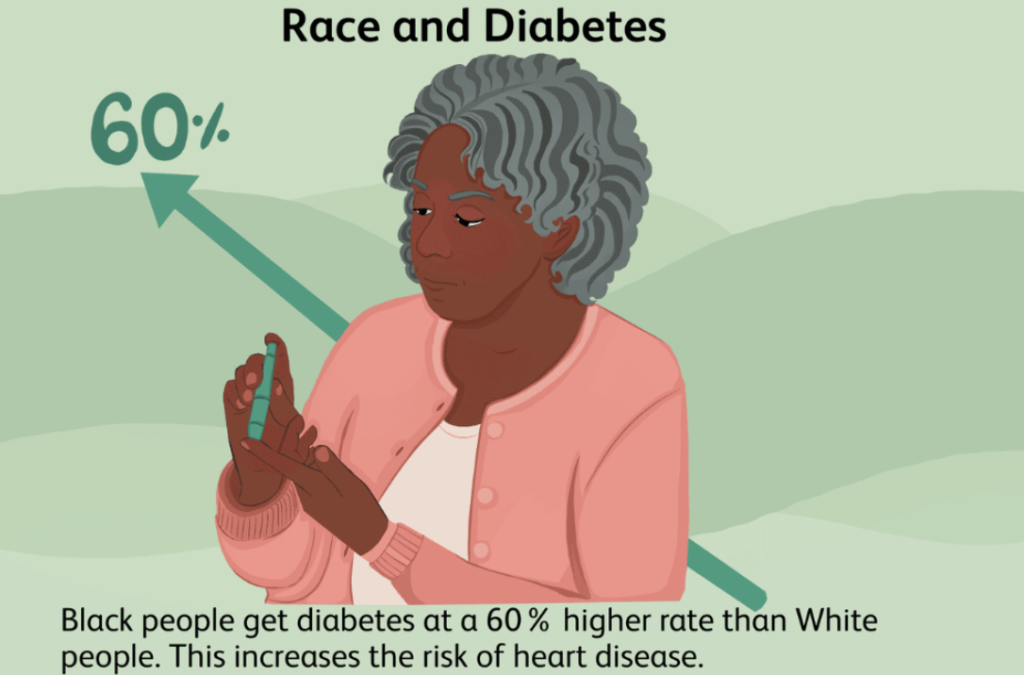diabetes
Blacks get diabetes 60% more than Whites. Know your risks and how to prevent the disease.
Diabetes
Know the risk factors
Blacks get diabetes 60% more than Whites. Know your risks and how to prevent the disease.
What is diabetes?
- Diabetes is a disease that occurs when your blood glucose, also called blood sugar, is too high.
- Insulin, a hormone made by the pancreas, helps move glucose from your bloodstream into your cells to be used for energy.
- With diabetes your body doesn’t make enough insulin, can’t use it as well as it should, or simply does not respond to it. As a result your blood glucose levels can become dangerously high.
symptoms
- New lump in the breast or underarm (armpit).
- Thickening or swelling of part of the breast.
Irritation or dimpling of breast skin. - Redness or flaky skin in the nipple area or the breast.
- Pulling in of the nipple or pain in the nipple area.
- Nipple discharge other than breast milk, including blood.
- Any change in the size or the shape of the breast.
- Pain in any area of the breast.
Risk Factors
- Getting older
- Genetic mutations
- Having dense breasts.
- Personal history of breast cancer
- Family history of breast or ovarian cancer
Ways to Prevent
Type 1 diabetes can’t be prevented. However, healthy lifestyle choices can help prevent and reduce the effects of prediabetes, type 2, and gestational diabetes:
- Eat healthy foods
- Get more physical activity
- Lose excess pounds
- Know your A1C
The A1C is a simple blood test done in a lab or at your doctor’s office. This test determines your average blood sugar level over the past 2 to 3 months.
For many adults with diabetes, the American Diabetes Association recommends an A1C goal of less than 7%.

Who is at RisK?
Type 1 Diabetes:
- Family history of diabetes
- Exposure to environmental factors or viruses
- Presence of damaging immune system cells
Type 2 Diabetes:
- Prediabetic
- Had gestational diabetes
- Being overweight or obese
- Having a parent or sibling with type 2 diabetes
- People of color are more at risk for diabetes
- 45 years or older
- Previous gestational diabetes
- Polycystic ovary syndrome
- Non-alcoholic fatty liver disease
- Having high blood pressure
- Abnormal cholesterol and triglyceride levels
Gestational Diabetes:
- Had gestational diabetes during a previous pregnancy
- Women older than age 25
- Family or personal history
- Being overweight before pregnancy
- Women of color are more at risk
- Have Polycystic ovary syndrome
treatment & complications
Controlling blood sugar (glucose) levels is the major goal of diabetes treatment.
- Type 1 diabetes is managed with insulin as well as dietary changes and exercise.
- Type 2 diabetes may be managed with non-insulin medications, insulin, weight reduction, or dietary changes.
Complications of Diabetes
The longer you have diabetes, and the less controlled your blood sugar is, the higher the risk of complications. Eventually, diabetes complications may be disabling or even life-threatening.
Complications of diabetes can include:
- An increased risk of heart disease or stroke.
- Excess sugar can injure the walls of the tiny blood vessels (capillaries) that nourish your nerves, especially in your legs. For men, it may lead to erectile dysfunction.
- Kidney failure or irreversible end-stage kidney disease, which may require dialysis or a kidney transplant.
- Damaged blood vessels of the retina potentially leading to blindness.
- Nerve damage in the feet or poor blood flow to the feet increases the risk of various foot complications. These infections may ultimately require toe, foot or leg amputation.
- Skin conditions including bacterial and fungal infections.
- Hearing problems are more common in people with diabetes.
- Type 2 diabetes may increase the risk of dementia, such as Alzheimer’s disease.
- Depression symptoms are common.
If you are experiencing any of these symptoms, you should get your blood sugar tested:
- Increased thirst
- Frequent urination
- Extreme hunger
- Unexplained weight loss
- Presence of ketones in the urine
- Fatigue
- Have very dry skin
- Blurred vision
- Slow-healing sores
- Frequent infections, such as gums or skin infections and vaginal infections
STATISTICS FOR PEOPLE OF COLOR

- More than 37 million people in the United States have diabetes, and 1 in 5 of them don’t know they have it.
- African Americans are almost twice as likely to be diagnosed with diabetes as non-Hispanic whites. In addition, they are more likely to suffer complications from diabetes, such as end-stage renal disease and lower extremity amputations.
- In 2018, non-Hispanic blacks were twice as likely as non-Hispanic whites to die from diabetes.
- African American adults are 60 percent more likely than non-Hispanic white adults to be diagnosed with diabetes by a physician.
- In 2017, non-Hispanic blacks were 3.2 times more likely to be diagnosed with end stage renal disease as compared to non-Hispanic whites.
- In 2017, non-Hispanic blacks were 2.3 times more likely to be hospitalized for lower limb amputations as compared to non-Hispanic whites.
Learn more about the Stats at GRAAHI's Health Equity Index
Links, Tools, Resources
Links to resources- assessments, diagnostic tools, more specific information/subtopics
- Take this quiz to find out you risk for prediabetes: https://www.cdc.gov/diabetes/takethetest/
- A diabetes education programs will help you gain the knowledge, skills and confidence to thrive with diabetes. Find a diabetes education program near you: https://www.diabetes.org/tools-support/diabetes-education-program
Lifestyle change programs exist to help you reduce your risk of type 2 diabetes and improve your overall health. Find a lifestyle change program near you: https://www.cdc.gov/diabetes/prevention/find-a-program.html
Grand Rapids/Kent County/Michigan Resources:
https://www.michigan.gov/mdhhs/keep-mi-healthy/chronicdiseases/diabetes
https://diabetes.org/get-involved/community/local-offices/michigan
https://www.livestories.com/statistics/michigan/kent-county-diabetes-deaths-mortality
https://readysetprevent.org/#prevent%20
Latest Advances, Clinical Trials & Breakthroughs in Diabetes
https://diabetes.org/about-us/research/research-impact/recent-advances
https://time.com/6197414/type-2-diabetes-latest-advancements/
https://www.ncbi.nlm.nih.gov/pmc/articles/PMC3498849/
Sources:
CDC, American Diabetes Association, National Library of Medicine, VeryWell Health, American Diabetes Association

